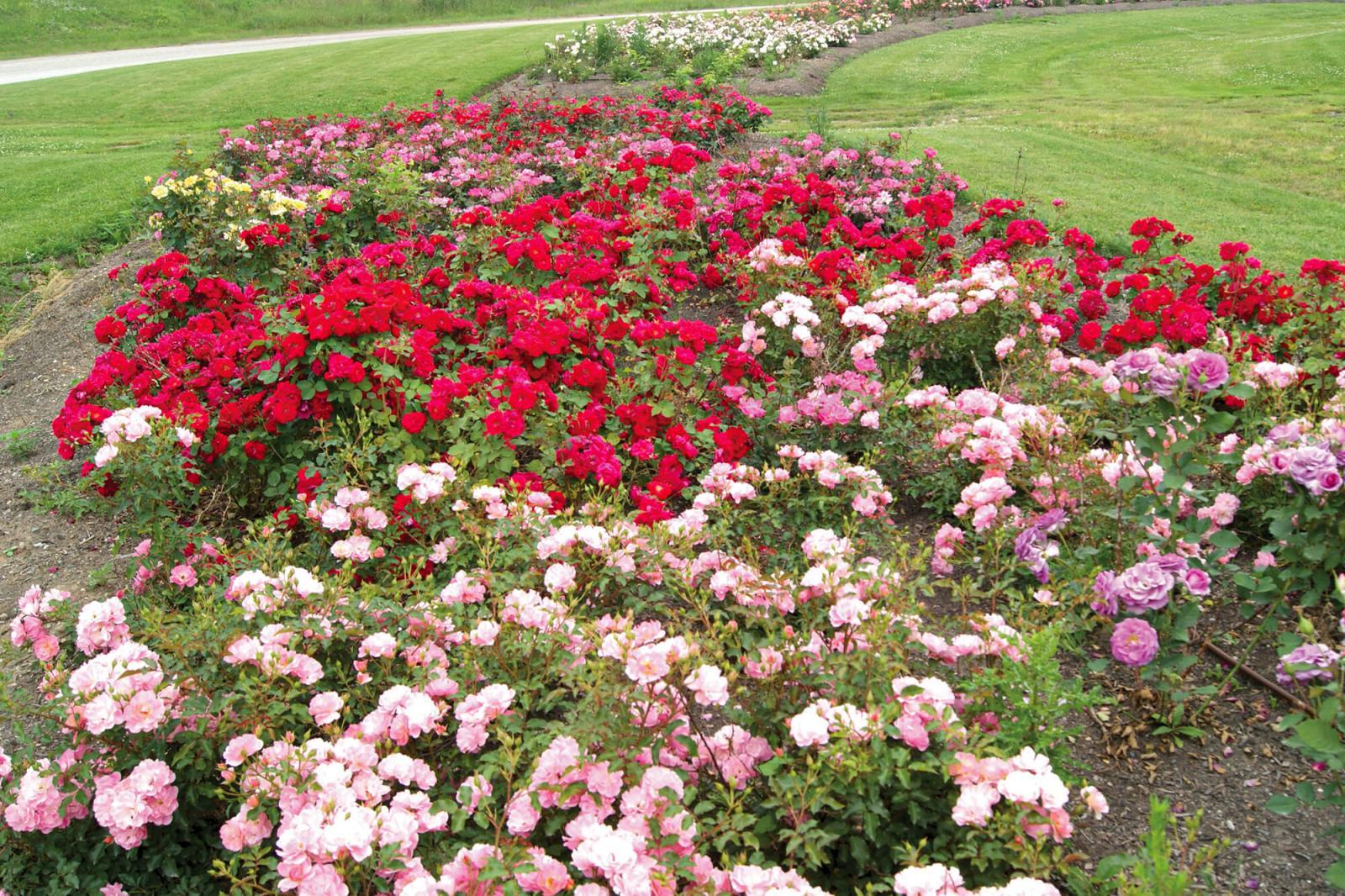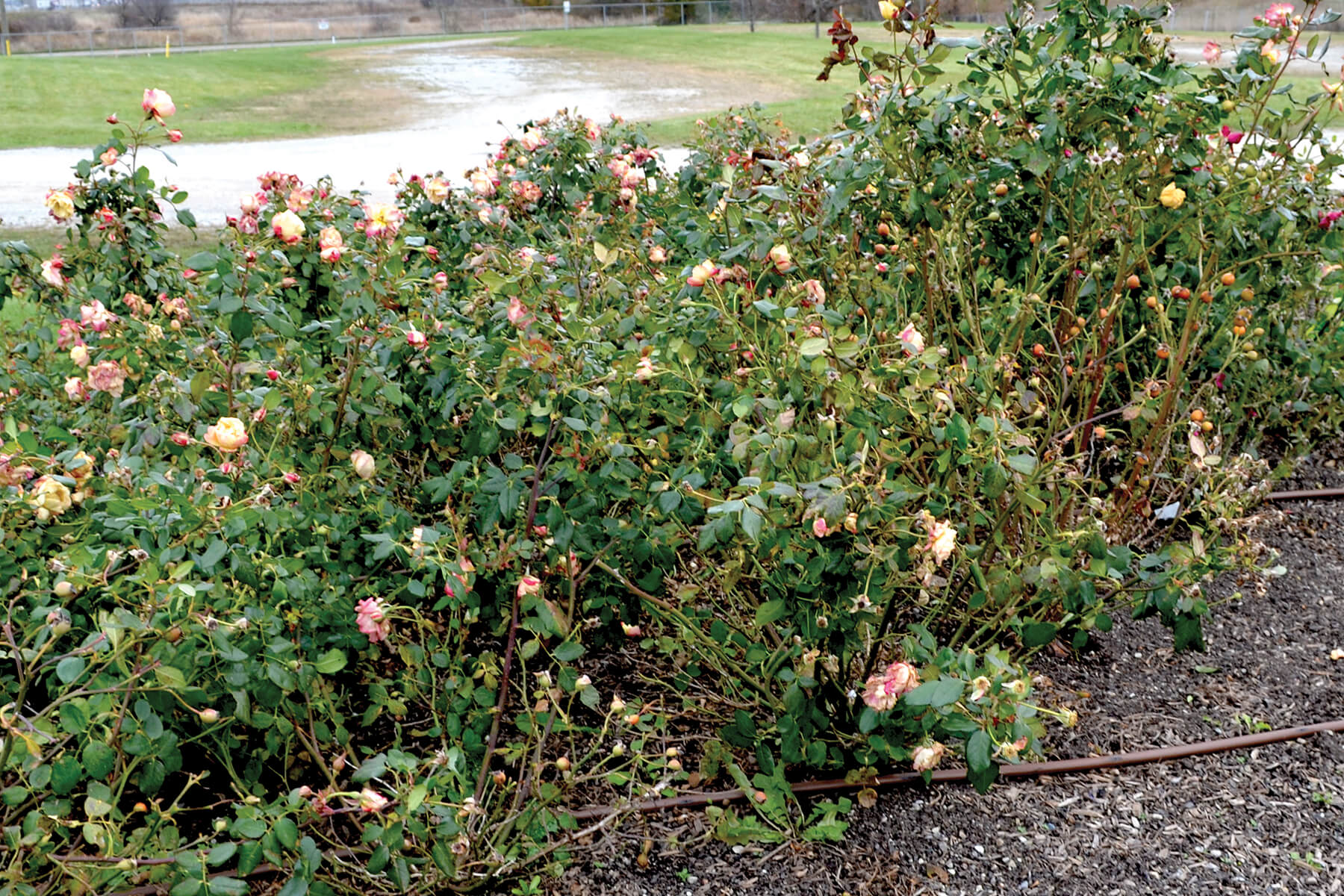March 15, 2014

Over 600 roses were donated by JC Bakker and Sons of St. Catharines to the Landscape Ontario trial gardens.
Rose trial reveals good prospects for the Ontario landscape industry
By Rodger Tschanz
University of Guelph
As I write this, Valentine’s Day has just passed. So, it seems appropriate to discuss roses in the landscape, even though all the greenery is still covered by a blanket of snow.
The roses mentioned in this article were donated by J.C. Bakker and Sons of St. Catharines, and planted at the Landscape Ontario Trial Garden site in Milton in the summer of 2012. The first formal evaluations of those plants took place in 2013, after the roses had a season to overwinter and become established.
Rose use in the landscape by consumers may be limited by perceptions of high maintenance and disease concerns. As is evident in the Landscape Ontario trial, not all roses are equal in regards to disease susceptibility and maintenance needs. The 2013 evaluations looked primarily at winter survival, length of bloom period, quantity of bloom and severity of blackspot and subsequent leaf drop.
 The Campfire rose was one of the best performers for the summer of 2013. It is pictured above in summer.
The Campfire rose was one of the best performers for the summer of 2013. It is pictured above in summer.
We found a great range of responses, with some cultivars experiencing 100 per cent survival, but 50 per cent stem dieback, while others had no winter injury, and still others barely came through the winter. To see the full range of responses, see the chart at http://gfl.me/x22l.
Most of the rose cultivars had a least a few plants survive the winter. Plants with dieback required more pruning and clean up in the spring, than those without winter injury. The cultivars with the least amount of winter dieback and highest winter survival rates included Belle Danielle, Bonica, Campfire, Emily Carr, Party Hardy and Siena Vigorosa.
 Campfire rose win early fall.
Campfire rose win early fall.
Once a killing frost struck the rose trial, many of the remaining flowers shriveled and turned brown. To have colour in the rose patch after frost is a desirable characteristic. Some of the cultivars maintained bloom or residual bloom colour; the frost-damaged petals did not turn brown, but maintained some of their original colour. Campfire, Carefree Celebration, Siena Vigorosa and Maxi Vita were the most colourful cultivars following frost.
Additional colour comes from rose hips, the fruit produced after successful pollination of rose flowers. Rose hips turn orange to red when mature and exposed to cool temperature in the fall. Rose hips can persist on the rose canes throughout the winter and contrast very nicely with snow. The list of rose cultivars producing rose hips is found in the online chart as well, but once again Campfire tops on the list.
 Campfire rose in November.
Campfire rose in November.
The best approach to deal with blackspot is to plant resistant cultivars. In the LO trial, a number of rose cultivars stood out as either being highly resistant or tolerant of blackspot throughout the growing season with minimal foliage loss. See the online table for the full list of foliage ratings. Pink Knock Out, Home Run and Pink Home Run had the best foliage in the 2013 trial.
Based on the observations from the 2013 rose trial, it would seem that some of the new rose cultivars have a place in the modern landscape where low maintenance, disease resistance and a long bloom period are desirable characteristics. That said, a number of questions weren’t addressed by the 2013 rose data collection.
For example, the intensity of flower fragrance and thorniness may interest those wanting fragrance to permeate a courtyard, or who are concerned about thorns or prickles affecting maintenance operations. There is wide range of differences between cultivars with respect to fragrance and thorniness. Hopefully these differences will be clearly identified in 2014. The extreme temperatures and snow of the 2013/2014 winter will provide additional selection pressure on the hardiness component of the rose trial.
New cultivars will be planted in the spring of 2014 to replace poor performers as the rose trial continues to identify good prospects for the Ontario landscape industry.
University of Guelph
As I write this, Valentine’s Day has just passed. So, it seems appropriate to discuss roses in the landscape, even though all the greenery is still covered by a blanket of snow.
The roses mentioned in this article were donated by J.C. Bakker and Sons of St. Catharines, and planted at the Landscape Ontario Trial Garden site in Milton in the summer of 2012. The first formal evaluations of those plants took place in 2013, after the roses had a season to overwinter and become established.
Rose use in the landscape by consumers may be limited by perceptions of high maintenance and disease concerns. As is evident in the Landscape Ontario trial, not all roses are equal in regards to disease susceptibility and maintenance needs. The 2013 evaluations looked primarily at winter survival, length of bloom period, quantity of bloom and severity of blackspot and subsequent leaf drop.
 The Campfire rose was one of the best performers for the summer of 2013. It is pictured above in summer.
The Campfire rose was one of the best performers for the summer of 2013. It is pictured above in summer.
Winter survival
The intention from Day One was for roses in this trial to be overwintered without the benefit of protection, such as mulching, hilling or wrapping in burlap; some winter injury was expected. Following the winter of 2012/13, and after growth began, different cultivars were evaluated for percentage plant survival and given a numerical rating on the degree of stem dieback during the winter.We found a great range of responses, with some cultivars experiencing 100 per cent survival, but 50 per cent stem dieback, while others had no winter injury, and still others barely came through the winter. To see the full range of responses, see the chart at http://gfl.me/x22l.
Most of the rose cultivars had a least a few plants survive the winter. Plants with dieback required more pruning and clean up in the spring, than those without winter injury. The cultivars with the least amount of winter dieback and highest winter survival rates included Belle Danielle, Bonica, Campfire, Emily Carr, Party Hardy and Siena Vigorosa.
 Campfire rose win early fall.
Campfire rose win early fall.
Flower and colour power
Of the 35 cultivars initially evaluated after the winter of 2012/13, 23 gave acceptable bloom performance throughout the 2013 growing season. The perfect rose should bloom continuously and heavily throughout the growing season. Although we may not have the perfect rose in our trials, we have a number of cultivars that come close to that mark. The top five bloomers, before the onset of frost in late October and November, are Pink Knock Out, Campfire, Home Run, Siena Vigorosa and Maxi Vita.Once a killing frost struck the rose trial, many of the remaining flowers shriveled and turned brown. To have colour in the rose patch after frost is a desirable characteristic. Some of the cultivars maintained bloom or residual bloom colour; the frost-damaged petals did not turn brown, but maintained some of their original colour. Campfire, Carefree Celebration, Siena Vigorosa and Maxi Vita were the most colourful cultivars following frost.
Additional colour comes from rose hips, the fruit produced after successful pollination of rose flowers. Rose hips turn orange to red when mature and exposed to cool temperature in the fall. Rose hips can persist on the rose canes throughout the winter and contrast very nicely with snow. The list of rose cultivars producing rose hips is found in the online chart as well, but once again Campfire tops on the list.
 Campfire rose in November.
Campfire rose in November.
Disease
Blackspot, the rose foliar disease caused by the fungus Diplocarpon rosae, is one of the main reasons given for not growing roses in the Ontario landscape. With this disease, blackspots first appear on the leaves, which gradually turn yellow and fall off the plant. This disease normally starts on the lower leaves and progresses upwards, often leaving rose canes completely denuded of foliage with a few rose buds at the tip. Wet or damp conditions exacerbate the spread of this disease. Very few chemical control options are available to the gardener or landscaper, and aren’t as effective as those available before the cosmetic pesticide ban came into effect.The best approach to deal with blackspot is to plant resistant cultivars. In the LO trial, a number of rose cultivars stood out as either being highly resistant or tolerant of blackspot throughout the growing season with minimal foliage loss. See the online table for the full list of foliage ratings. Pink Knock Out, Home Run and Pink Home Run had the best foliage in the 2013 trial.
Based on the observations from the 2013 rose trial, it would seem that some of the new rose cultivars have a place in the modern landscape where low maintenance, disease resistance and a long bloom period are desirable characteristics. That said, a number of questions weren’t addressed by the 2013 rose data collection.
For example, the intensity of flower fragrance and thorniness may interest those wanting fragrance to permeate a courtyard, or who are concerned about thorns or prickles affecting maintenance operations. There is wide range of differences between cultivars with respect to fragrance and thorniness. Hopefully these differences will be clearly identified in 2014. The extreme temperatures and snow of the 2013/2014 winter will provide additional selection pressure on the hardiness component of the rose trial.
New cultivars will be planted in the spring of 2014 to replace poor performers as the rose trial continues to identify good prospects for the Ontario landscape industry.